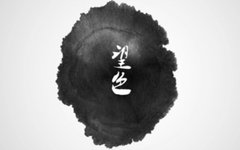Traditional Chinese Medicine Diagnosis – Observation Diagnosis
Observing Color
Today we will learn about the second part of whole-body observation diagnosis – observing color.
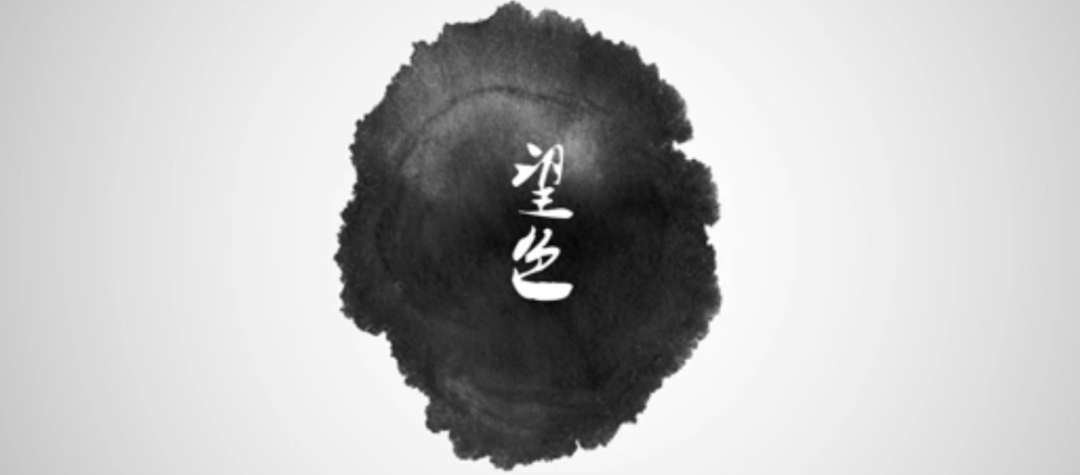
Color refers to the hue and luster. Observing color involves examining the changes in skin color across the patient’s body, primarily focusing on the changes in facial skin color to assess the condition. The main content of observing color includes the hue of the body surface mucosa, secretions, and excretions. In this chapter, we will focus on the color of the facial skin.

(1) The Principle of Diagnosing Disease by Observing Color
How can observing color diagnose diseases?
The principle is mainly reflected in three aspects. First, the five zang organs and six fu organs are connected to the face through the meridians. For example, the heart governs blood vessels, and its manifestation is on the face; the three yang meridians of the hands and feet ascend to the head and face; the foot yangming stomach meridian, abundant in qi and blood, is distributed in the head and face. Therefore, observing the color of the face can reflect the condition of the five zang organs and six fu organs. Another aspect is the relationship between color and qi. The “Four Diagnostic Methods” states: “Qi arises from the zang, and color follows the flourishing of qi.” This indicates that the skin color of the human body shines outward with the nourishment of essence and qi. Since essence and qi are produced by the functional activities of the zang and fu organs, the luster of the skin reflects the abundance or deficiency of the essence and qi of the zang and fu organs. Additionally, there is the relationship between color and spirit. The “Medical Laws” states: “Color is the flag of the spirit; when the spirit is vigorous, the color is vibrant; when the spirit is weak, the color is dull.” This indicates that the spirit is the external manifestation of the essence and qi of the zang and fu organs. The luster and dullness of the skin color reflect whether the spirit and qi are sufficient or not. Therefore, observing the color of the skin can reflect the abundance or deficiency of the essence and qi of the zang and fu organs. Color is the external manifestation of the essence and qi of the zang and fu organs, and through observing color, one can diagnose the abundance or deficiency of the essence and qi of the five zang organs and six fu organs.

(2) Facial Areas Related to the Zang and Fu Organs
1. The “Lingshu – Five Colors” Division Method (see the diagram below)
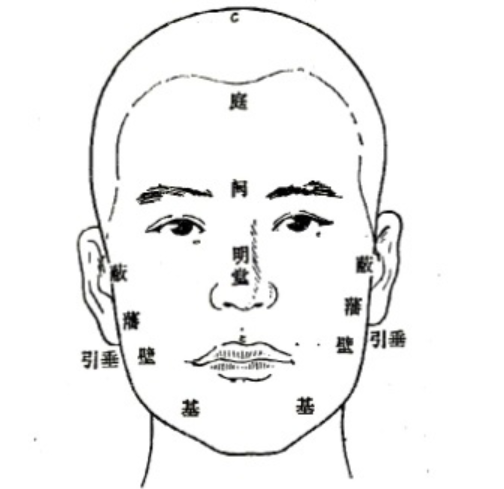
The “Lingshu – Five Colors” Diagram of the Ming Hall
Nose – Ming Hall.
Between the eyebrows – Que.
Forehead – Ting (Face).
Cheek sides – Fan.
Ear gate – Bi.
2. The “Lingshu – Five Colors” Facial Color Diagnosis Division (see the diagram below)

The “Lingshu – Five Colors” Facial Color Diagnosis Division Diagram
Ting – Face;
Above Que – Throat; Middle Que (Yintang) – Lung; Below Que (Lower Extremity, Mountain Root) – Heart;
Below Lower Extremity (Years of Life) – Liver; Liver sides – Gallbladder; Below Liver (Tip) – Spleen;
Above (Sides of Spleen) – Stomach;
Center (Below Cheekbone) – Large Intestine; Next to Large Intestine – Kidney;
Above Ming Hall (Nasal Tip) – Small Intestine; Below Ming Hall – Bladder.
3. The “Suwen – Needle Heat” Division Method (see the diagram below)
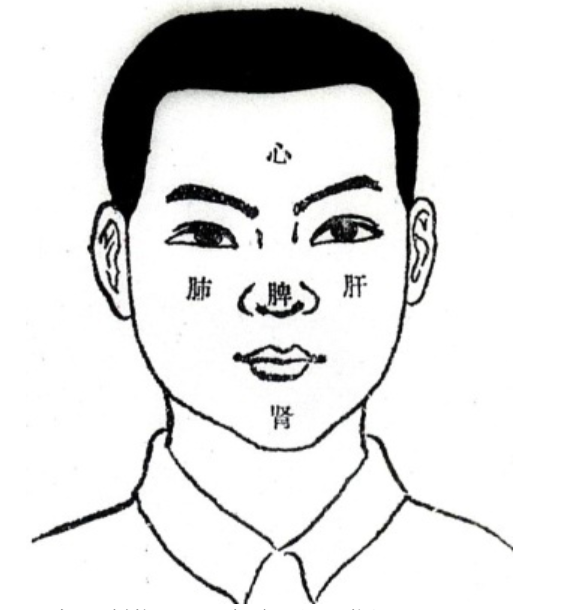
The “Suwen – Needle Heat” Facial Color Diagnosis Division Diagram
Left Cheek – Liver;
Right Cheek – Lung;
Forehead – Heart;
Chin – Kidney;
Nose – Spleen.
(3) The Significance of Color and Luster
Normal facial color is a manifestation of abundant blood, which we Chinese often describe as having color. Therefore, color reflects the abundance and deficiency of blood and the condition of diseases. Having color indicates sufficient blood, hence we say that having color means blood is present.
Pathological colors can usually reflect the different locations of diseases in the zang and fu organs, based on the principle of matching five colors to five zang organs. The changes in colors corresponding to the diseases of the liver, heart, spleen, lung, and kidney are green, red, yellow, white, and black.
Pathological colors can also reflect the different natures of diseases. For example, green and black indicate pain, yellow and red indicate heat, and white indicates cold.

1. Color: Skin color (changes in hue) – green, red, yellow, white, black.
(1) Physiological: Reflects the abundance and deficiency of blood and its circulation. “Having color means blood is present”.
(2) Pathological: Reflects the different natures of diseases – “green and black indicate pain, yellow and red indicate heat, white indicates cold.”
Reflects the diseases of different zang and fu organs – “five colors match five zang organs.” Green corresponds to the liver, red to the heart, yellow to the spleen, white to the lung, and black to the kidney.
2. Luster: Skin luster (changes in brightness) – moist and bright, dull and withered.
(1) Physiological: Reflects the abundance and deficiency of the essence and qi of the zang and fu organs. “Having luster means qi is present”.
(2) Pathological: Determines the severity of the disease and prognosis.
Bright and moist facial color – the essence and qi of the zang and fu organs are not deficient, indicating no disease or mild disease, with a good prognosis.
Dull and withered facial color – the essence and qi of the zang and fu organs are deficient, indicating severe disease, with a poor prognosis.
Moist and bright is also called having luster, while dull and withered is called lacking luster.
What is having luster? What is lacking luster?


We can use two writing boards as an example. For instance, this is a white board that reflects light, while this black board does not reflect light. From this, we can see that having reflection means having luster, while lacking reflection means lacking luster.
Next, we will use facial color as an example:
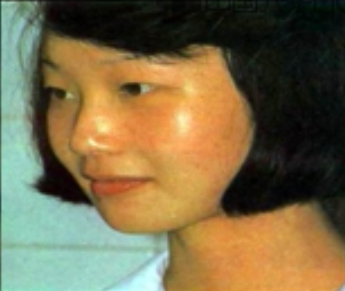

For example, these two individuals have a yellowish complexion. The first one has a slightly lustrous complexion, while the second one appears yellow and sallow without luster.
In contrast, these two patients with jaundice: the first has a bright yellow with luster, while the second has a dull yellow without luster.
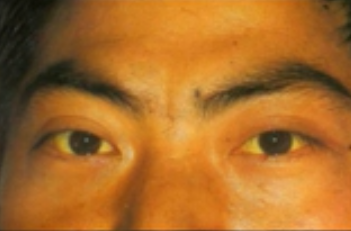

We see that having luster shows a reflective quality on the face, while a patient lacking luster appears sallow and does not reflect light. Thus, we can simply say that the presence or absence of luster is primarily reflected through the facial reflection.
3. The significance of observing color and luster:
(1) Understanding the deficiency or excess of the zang and fu organs, and the abundance or deficiency of qi and blood;
(2) Reflecting the nature and location of diseases;
(3) Judging the severity of the disease and prognosis.
(4) Normal Color vs. Pathological Color
1. Normal Color: The color of the facial skin of a healthy person (i.e., normal, disease-free complexion).
(1) Characteristics: Bright, moist, and subtle.
Bright and moist refers to the facial skin being bright and lustrous, which is related to the abundance of essence and qi, and the vigor of qi, blood, and fluids. Subtle means that the facial color is a subtle red-yellow that is not overtly visible, indicating that the stomach qi is sufficient, and the essence is contained within and not leaked outward.
☻ The normal complexion of Chinese people: subtle red-yellow, bright, and subtle.

(2) Classification:
Main Color: The normal color of the skin that remains unchanged throughout life due to individual ethnicity and constitution. Also known as the true color.
Guest Color: The normal changes in facial color due to external factors (such as seasons, climate, day and night, etc.) or differences in living conditions.
2. Pathological Color: Abnormal changes in facial color due to disease.
(1) Characteristics: Dull, exposed – indicating that the essence and qi of the zang and fu organs have declined, and the stomach qi cannot nourish the face.
(2) The five colors of good and evil:

(5) The Five Colors and Their Associated Diseases
[Meaning] The five colors associated with diseases refer to the method of diagnosing diseases based on the changes in the five colors of the patient’s face. Also known as five-color diagnosis.
1. White: Indicates deficiency syndromes, cold syndromes, blood loss, and loss of qi.

2. Yellow: Indicates spleen deficiency and dampness.

3. Red: Indicates heat syndromes, and can also be seen in yang syndromes.

4. Green: Indicates cold syndromes, pain, qi stagnation, blood stasis, and convulsions.
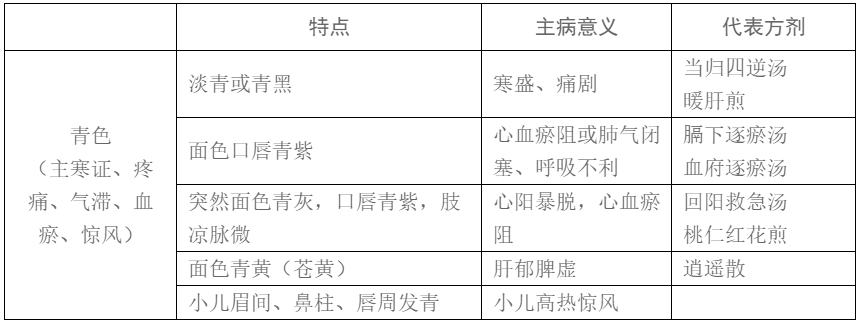
5. Black: Indicates kidney deficiency, cold syndromes, water retention, and blood stasis.

(6) Considerations for Observing Color
1. Understand the normal and abnormal, and make comprehensive judgments;
2. Focus on the whole, with luster and dullness as key indicators;
3. Eliminate interference and distinguish false appearances; (especially pay attention to the effects of light, day and night, emotions, diet, etc. on color)
4. Pay attention to the dynamic changes in facial color diagnosis.

☻ The Ten Methods of Observing Color: This method analyzes the nature, location, and progression of diseases based on ten categories of changes in facial skin color (floating, sinking, clear, turbid, slight, severe, scattered, concentrated, luster, and dull).
Floating, clear, slight, scattered, luster – indicate exterior diseases, mild conditions, and new diseases;
Sinking, turbid, severe, concentrated, dull – indicate interior diseases, severe conditions, and chronic diseases.
Additionally, we must consider the impact of emotions. For example, joy can cause the spirit to be exuberant, leading to a flushed complexion; anger can cause liver qi to rebel, leading to a greenish complexion; depression can cause qi to stagnate, leading to a dull complexion; excessive thinking can cause qi to stagnate in the spleen, leading to a yellow complexion; and fear can lead to a scattered spirit, resulting in a pale complexion.

Finally, we should also consider the impact of diet. For instance, after drinking alcohol, the blood vessels expand, leading to a flushed face; after a full meal, the stomach qi is abundant, resulting in a bright and lustrous complexion; excessive hunger can lead to a reduction in stomach qi, causing a dull complexion and lack of luster.
The Five-Color Diagnosis for Health: The changes in the color of the facial skin can be used to assess the condition of diseases and diagnose the abundance or deficiency of the essence and qi of the five zang organs and six fu organs. Therefore, when facial color appears abnormal, it is essential to pay attention, as this may be the body sending a warning!


Chinese herbal formulas, meridian points, and pathological differentiation are compared item by item, with clear illustrations.
Long press the QR code to scan and download the Great Traditional Chinese Medicine Encyclopedia, gathering the strengths of many schools and sharing thousands of years of classics.
Click the lower right corner “Looking” and share with more people~


